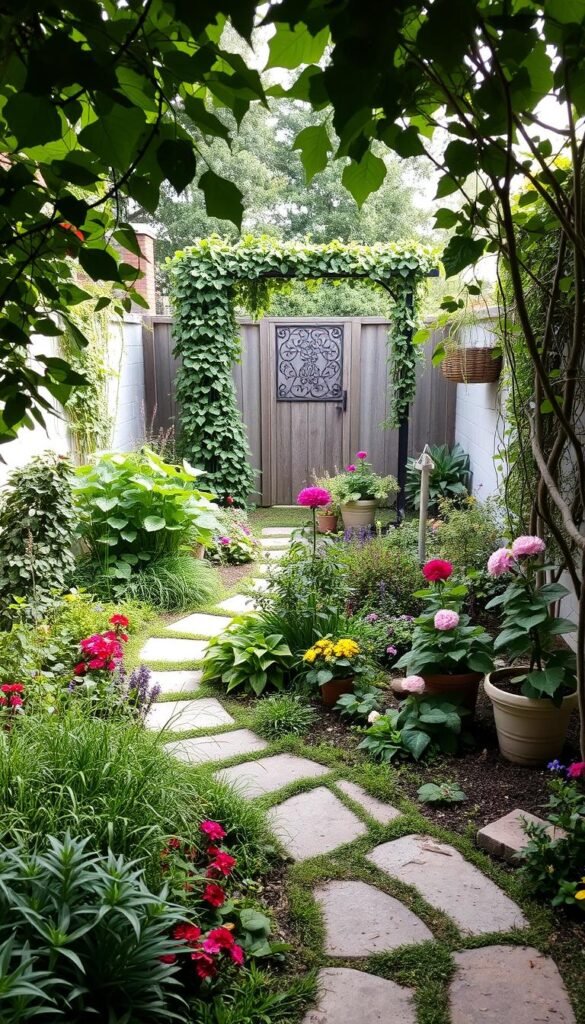Imagine stepping into a vibrant oasis right outside your door, even if your outdoor area feels cramped. You don’t need sprawling acres to grow lush greens or colorful blooms. Many urban gardeners have transformed compact 40×100-foot lots into thriving green spaces using smart design strategies that squeeze every drop of potential from their backyard.
Start by seeing your entire property through a gardener’s lens. That narrow side yard? Perfect for vertical planters. The shady spot under trees? Try shade-loving hostas or ferns. Even challenging areas with heavy roots or limited sunlight can become productive with the right approach. One passionate grower turned a root-filled corner into a stunning fern grove by using raised beds—proving creativity beats square footage.
Successful small-space gardening means balancing dreams with reality. You’ll learn how to prioritize plants that deliver big rewards, like trellised cucumbers that use 75% less ground space than bush varieties. Avoid common small-space gardening mistakes by planning for proper spacing and soil health from the start.
Your outdoor living areas don’t have to disappear. Clever layouts let you entertain guests amid fragrant herbs or tuck a cozy seating nook between raised beds. The secret lies in viewing every inch as multi-functional space—where beauty meets practicality.
Getting Started with Your Small Backyard Garden
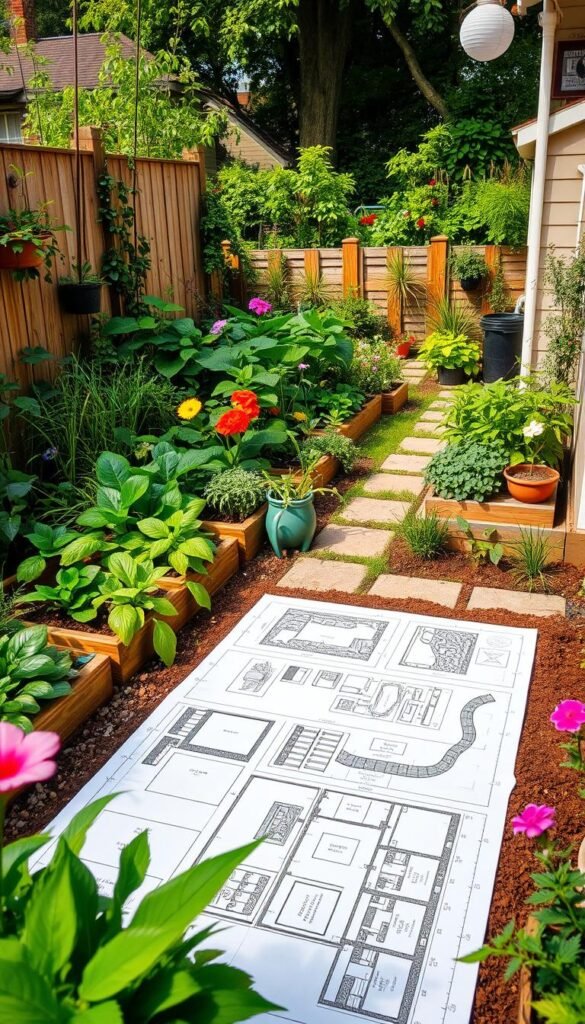
Launching your green journey begins with thoughtful preparation. While enthusiasm runs high, biting off more than you can chew leads to frustration. Over 60% of first-time growers abandon their plots by midsummer due to unrealistic plans. Let’s create a setup that grows with you, not against you.
Understanding Your Space and Goals
Grab a notebook and answer three questions: What do you want to grow? How many minutes daily can you dedicate? What existing features (like trees or patios) shape your yard? A 10’x10’ area lets you plant 8-10 veggies while leaving room to maneuver. Want fresh salads? Focus on leafy greens and cherry tomatoes. Craving color? Mix flowers like marigolds among your crops.
Setting Realistic Expectations
Social media’s picture-perfect gardens often hide hours of unseen labor. Instead of copying influencers, build habits that fit your lifestyle:
- Start with 15 minutes daily for watering/weeding
- Choose 3-5 easy plants (like zucchini or basil)
- Use vertical planters to save ground space
One Chicago gardener harvested 50 lbs of produce from just 100 sq ft by focusing on high-yield crops. Remember: A thriving pocket-sized plot beats a half-dead field every time.
Assessing Your Outdoor Priorities and Layout
Transforming a compact backyard begins with clarity about what matters most. Before sketching your design, grab a pen and list every feature you’d love—from herb spirals to fire pits. Then, rank them ruthlessly. A dining area for family meals might outweigh that Instagram-worthy koi pond when space is scarce.
Identifying Essential Features
Separate “must-haves” from “nice-to-haves” by asking: Will this serve daily needs? A Minneapolis gardener swapped her dream waterfall for raised vegetable beds after realizing her kids needed snack-ready strawberries. Functional areas like seating or pathways should anchor your plan, while decorative elements fill gaps.
Evaluating Traffic Flow and Functionality
Walk through your property mentally. Where do people naturally move? Keep main routes at least 3 feet wide—narrower paths become tripping hazards. Pair practicality with beauty by lining walkways with fragrant lavender or colorful annuals that enhance your garden’s visual flow.
Track sunlight patterns across different areas using free apps like Sun Seeker. That sunny corner perfect for tomatoes? Reserve it. Shady spots become cool retreats with benches and ferns. By mapping your space with intention, you’ll create a layout that works as hard as you do.
Design Strategies for a Lush and Organized Garden
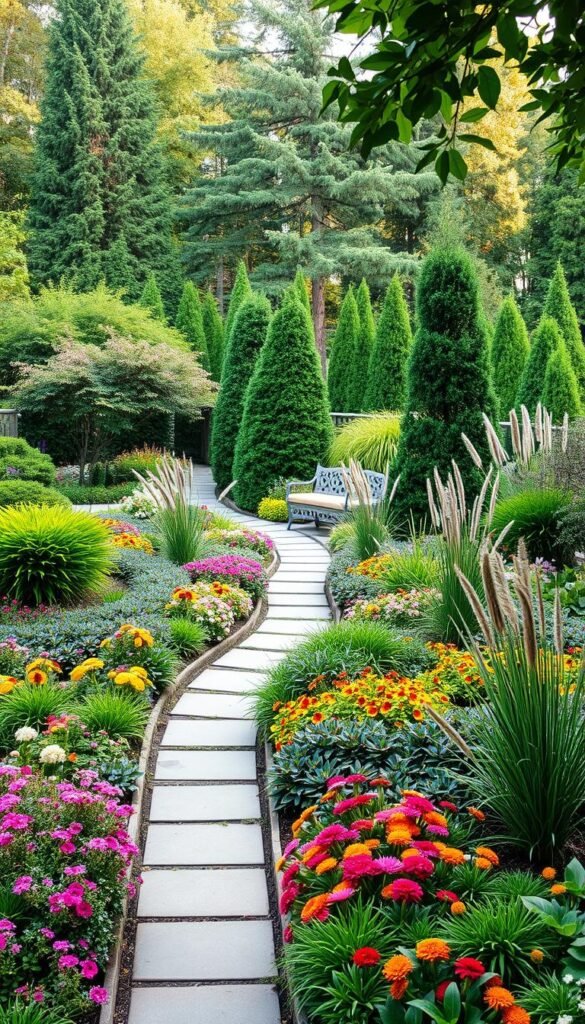
Crafting a garden that feels both abundant and orderly starts with strategic design choices. The key lies in creating layers of interest without letting your space become a jungle. Start by grouping similar plants in odd-numbered clusters—three or five of the same species—to build rhythm while avoiding monotony.
Balancing Fullness with Clarity
Resist the urge to fill every inch immediately. Leave 30% of your garden empty during initial planting. This allows room for growth and prevents overcrowding. A Seattle gardener achieved a polished look by spacing perennials 18 inches apart, giving each plant breathing room while maintaining density.
Use these techniques to harmonize your layout:
| Strategy | Implementation | Visual Impact |
|---|---|---|
| Repetition | Repeat 2-3 anchor plants | Creates unity |
| Color coordination | Limit palette to 4 hues | Enhances beauty |
| Structural plants | Add boxwoods or grasses | Defines space |
Edit ruthlessly every spring. If a plant outgrows its spot or blocks sunlight, relocate or remove it. One New York grower swaps out 20% of her plants annually to maintain balance. Remember: A well-planned garden matures gracefully instead of chaotically.
Notice when pathways narrow or leaves overlap excessively—these signal it’s time to prune. Pair vertical growers like clematis with low-spreading thyme to maximize layers. Your design will feel intentional, not wild, while keeping that coveted lushness.
Essential Tips for Planning a Small Backyard Garden Without Wasting Space
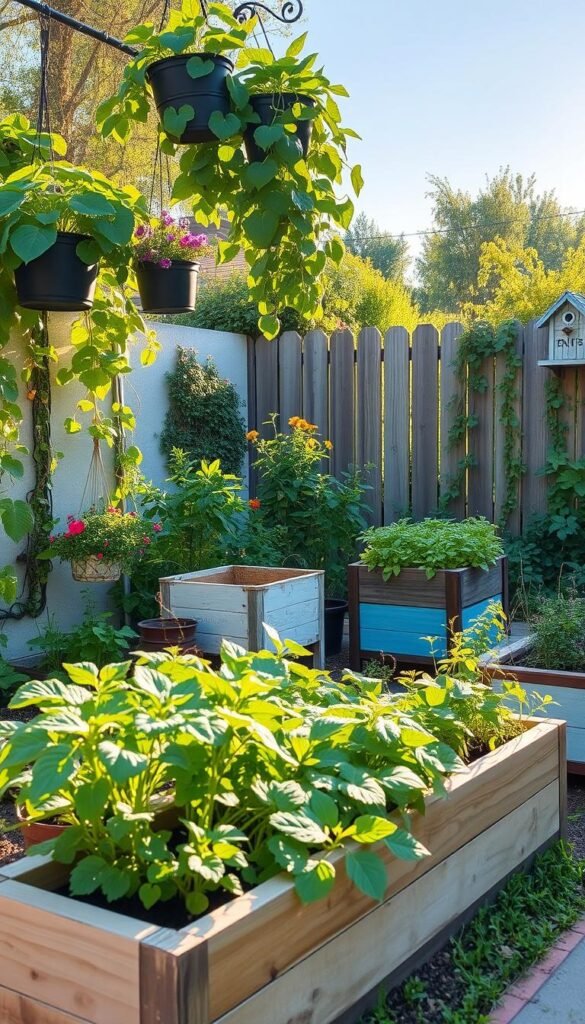
Discover how overlooked spaces can become your garden’s most productive zones. That rocky slope by your driveway? A prime spot for drought-tolerant sedums. The cramped alley between houses? Ideal for stacking strawberry towers. One gardener transformed a jagged retaining wall into a cascading display of creeping thyme and ice plants—proof that limitations spark innovation.
Step-by-Step Planning Insights
Start by mapping your property’s micro-environments. Use colored chalk to mark:
- Sun exposure (full/partial/shade)
- Soil type (rocky, clay, etc.)
- Existing structures (walls, fences)
A Phoenix homeowner doubled her growing area by recognizing her south-facing brick wall reflected heat—perfect for peppers. This table helps match challenging spots with solutions:
| Location | Strategy | Plant Examples |
|---|---|---|
| Rocky slopes | Terracing with gravel beds | Lavender, succulents |
| Narrow side yards | Vertical pallet gardens | Herbs, nasturtiums |
| Shady corners | Moss gardens | Ferns, hostas |
Maximizing Every Inch
Choose plants that work overtime. Russian sage offers purple blooms and deer resistance. Dwarf fruit trees provide snacks while fitting tight spaces. For year-round color:
- Spring: Crocuses in pavement cracks
- Summer: Climbing beans on fences
- Fall: Ornamental grasses in containers
Remember: Packed gardens need smart upkeep. Schedule 10-minute daily walkthroughs to prune overcrowded stems or refresh mulch. Your garden will stay lush without becoming overwhelming.
Maximizing Vertical Space and Container Gardening
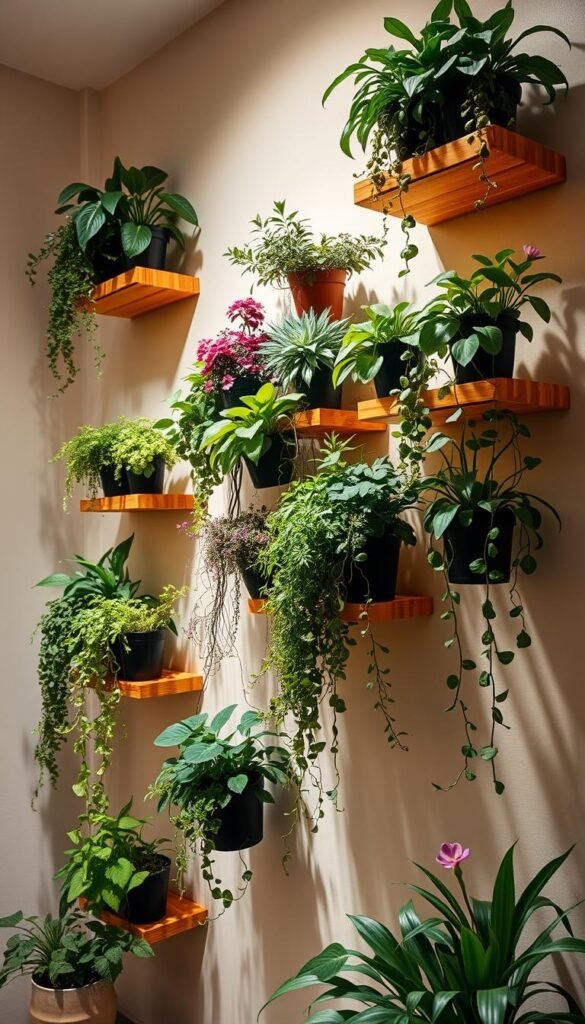
Reach new heights in your growing ambitions by thinking beyond ground level. Vertical solutions let you triple planting areas while adding striking architectural elements to your layout. A Portland gardener harvested 80 cucumbers weekly using just 4 sq ft of ground space with overhead trellising.
Using Trellises and Raised Beds
Train vining plants upward with these smart supports:
- Cattle panel arches for winter squash
- Tepee structures with bamboo poles
- Wall-mounted grids for cherry tomatoes
Raised beds solve drainage issues and protect roots from tree competition. Build them 18-24″ tall for easy access. One Wisconsin grower increased pepper yields by 40% using elevated planters with custom soil blends.
Choosing Containers for Better Control
Pots let you customize conditions for fussy plants. Hostas thrive in shaded containers under trees, while rosemary prefers terra cotta pots in sunny spots. Match materials to needs:
| Container Type | Best For | Pro Tip |
|---|---|---|
| Fabric bags | Root vegetables | Prevents overwatering |
| Self-watering boxes | Leafy greens | Reduces daily care |
| Hanging baskets | Strawberries | Saves ground space |
Incorporating Color and Architectural Elements
Paint containers in hues that complement your home’s trim for instant cohesion. Try cobalt blue pots against white siding or earthy terracotta near brick walls. Vertical structures do double duty—steel arbors support beans while creating shaded seating nooks.
Group planters in odd numbers near entryways for welcoming bursts of color. One Maryland gardener transformed her concrete patio using staggered shelves of red geraniums and trailing sweet potato vines. Remember: Every upward inch counts when ground space is precious.
Creative Seating and Outdoor Room Concepts
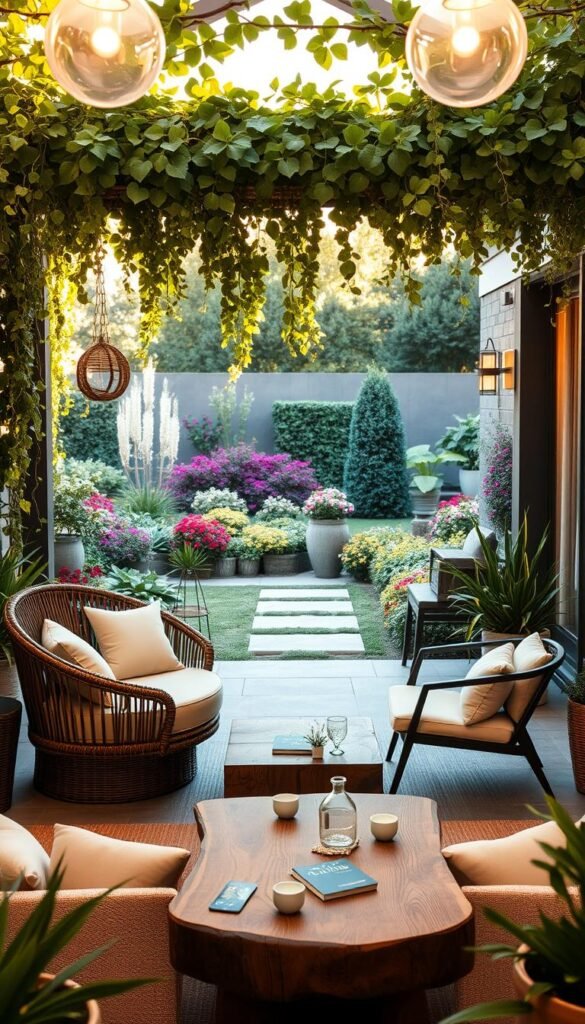
Your tiny backyard becomes an inviting retreat when seating pulls double duty. Smart arrangements turn tight spaces into functional zones that feel expansive. The secret? Position chairs and benches to frame your best views while hiding less attractive elements.
Designing Multifunctional Areas
Tuck a pair of cobalt blue chairs in the farthest corner against your fence. This creates a private nook that blocks neighboring house views while using vertical boundaries as natural backdrops. The winding path to this spot becomes a mini adventure—each step reveals new plant textures and colors.
Try these space-stretching tricks:
- Angle semi-circular benches to wrap around areas, creating intimate “rooms”
- Use storage ottomans as extra seats or side tables
- Align seating diagonally to make yards appear 20% larger
A curved bench placed near flowering shrubs does triple duty. It defines the space, guides foot traffic around garden beds, and offers front-row seats to your blooms. One Denver homeowner transformed her 8’x10′ patio into three distinct zones using strategically placed stools and planter-ledges.
| Seating Type | Space Benefit | Visual Trick |
|---|---|---|
| Curved bench | Defines room edges | Softens angles |
| Foldable chairs | Saves floor space | Adds height variation |
| Built-in ledges | Doubles as plant display | Extends sight lines |
Choosing the Right Plants and Garden Beds
Your plate holds the blueprint for your garden’s potential. Start by tracking the veggies you buy weekly—those frequent purchases become prime candidates for your garden. A Boston family cut their grocery bills by 30% after growing kale and cherry tomatoes they previously bought every Thursday. Focus on high-value crops that thrive in limited space, like leafy greens and bush beans.
Plant Selection Based on Area and Light
Match crops to your space like puzzle pieces. Sun-loving tomatoes need 6-8 hours of direct light, while spinach tolerates shade. Use this quick guide:
| Sun Exposure | Best Vegetables | Space per Plant |
|---|---|---|
| Full sun | Peppers, zucchini | 2-3 sq ft |
| Partial shade | Lettuce, Swiss chard | 1 sq ft |
For tight quarters, try compact varieties like ‘Patio Pride’ peppers. These grow well in containers and raised beds.
Optimizing Beds and Raised Garden Areas
Design beds like a chessboard—strategic placement wins the game. Pair tall plants with low growers: trellised cucumbers behind radishes. Try these layout hacks:
- Stagger planting dates for continuous harvests
- Use hexagonal spacing to fit 15% more plants
- Edge beds with thyme to repel pests naturally
Raised beds let you control soil quality—crucial for nutrient-hungry veggies. Mix compost and vermiculite for optimal drainage. Follow soil prep guidelines to avoid common mistakes.
Incorporating Visual Tricks and Sustainable Practices
Transform your compact outdoor area into a spacious retreat using clever visual strategies. Simple tweaks like removing obstructive railings can dramatically open sightlines, making your garden feel twice its actual size. Clean edges between lawn and planting zones add polished definition, while strategic color placement guides the eye through your space effortlessly.
Using Visual Cues to Expand Perceived Space
Swap solid fences for open lattice panels to create depth. Position bold-colored flowers at the far end of narrow areas—their vibrancy draws attention outward. A curved gravel path lined with low-growing thyme tricks the brain into perceiving more square footage than physically exists.
Integrating Sustainable and Low-Maintenance Elements
Replace thirsty grass with drought-tolerant sedum mats or clover lawns. Native plants like coneflowers thrive with minimal care while supporting local pollinators. Artificial turf in high-traffic zones stays green year-round without watering—perfect between raised beds or under seating designs.
These smart approaches let you enjoy your garden more and work less. By blending visual magic with earth-friendly choices, you’ll craft an outdoor haven that feels expansive yet stays manageable.

